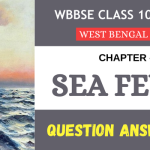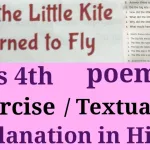Sample Questions and Answers:
Q1: Why was the young seagull afraid to fly?
A: The young seagull was afraid to fly because he doubted that his wings would support him. He feared falling into the vast sea below.
Q2: How did the seagull’s parents encourage him to fly?
A: His parents coaxed and scolded him, even threatening to let him starve unless he flew. They demonstrated flying and tried to motivate him by showing how his siblings were flying.
Q3: What role did hunger play in the seagull’s first flight?
A: Hunger became unbearable for the young seagull. When he saw his mother with food, he dived towards it, forgetting his fear, which led to his first flight.
Q4: Describe the seagull’s feelings during his first flight.
A: Initially, he was terrified, but as he started flying, he felt exhilarated and joyful, realizing he could fly.
Q5: What is the central theme of ‘His First Flight’?
A: The story emphasizes overcoming fear and gaining confidence through self-belief and courage.
Q6: How did the seagull’s family react to his first flight?
A: They were overjoyed, flying around him and celebrating his success by offering him food.
Q7: What lesson does the story teach about facing fears?
A: It teaches that confronting and overcoming fears is essential for growth and achieving one’s potential.
Q8: Why did the mother seagull stop midway with the food?
A: She wanted to entice her son to fly by making him come to her, using hunger as motivation.
Q9: How did the young seagull feel after landing on the sea?
A: He was initially scared, thinking he would drown, but then felt relieved and proud upon realizing he could float.
Q10: What does the story suggest about parental guidance?
A: It highlights the importance of supportive yet firm parental guidance in helping children overcome their fears.
Q11: How does the story relate to human experiences?
A: Just like the seagull, humans often fear trying new things, but with encouragement and self-belief, they can succeed.
Q12: What was the young seagull’s initial reaction to flying?
A: He was filled with fear and hesitation, doubting his ability to fly.
Q13: How did the seagull’s siblings contribute to his learning?
A: Their successful flights served as examples and motivation for him to try flying.
Q14: What does the sea symbolize in the story?
A: The sea represents the vast challenges and opportunities that lie ahead once one overcomes fear.
Q15: How is the story relevant to students?
A: It encourages students to face academic and personal challenges with courage and determination.
Q16: What literary devices are used in the story?
A: The story uses imagery and symbolism to convey the seagull’s emotions and the theme of overcoming fear.
Q17: How does the author build tension in the narrative?
A: By describing the seagull’s fear and the family’s reactions, the author creates suspense leading up to the first flight.
Q18: What is the significance of the title ‘His First Flight’?
A: It underscores the importance of taking the first step towards independence and self-reliance.
Q19: How does the story end?
A: With the young seagull successfully flying and joining his family, symbolizing his growth and confidence.Learn
Q20: What can readers learn from the young seagull’s experience?
A: That facing and overcoming fears is a crucial part of personal developmen.
Books with Author Names, Publishers, and Content Types:
1. Class 10 English Companion – First Flight
Author: Dr. S.K. Arora
Publisher: Full Marks Pvt. Ltd.
Content Type: Chapter-wise textbook questions, value-based questions, grammar exercises.
2. Together with English Language & Literature
Author: Rachna Sagar
Publisher: Rachna Sagar Pvt. Ltd.
Content Type: Practice questions, extract-based questions, model answers, and MCQs.
3. CBSE Chapterwise Solutions English Class 10
Author: Editorial Board
Publisher: Arihant Publications
Content Type: Solved board exam questions, short and long answers, sample question papers.
4. Golden Guide English Literature – First Flight
Author: N.K. Aggarwala
Publisher: New Age Publishers
Content Type: Textual Q&A, explanation of story events, theme analysis.
5. English Communicative Class 10
Author: Oswal Editorial Board
Publisher: Oswal Publishers
Content Type: Objective questions, analytical and HOTS (High Order Thinking Skills) questions.
6. English Language & Literature Sample Papers
Author: M.B. Lal
Publisher: MTG Learning Media
Content Type: Sample papers, writing skills, comprehension-based questions.
7. Xam Idea English Class 10
Author: Xam Idea Editorial Team
Publisher: VK Global Publications
Content Type: Chapter summary, key concepts, long and short questions with answers.
8. Exam Idea English Literature
Author: Panel of Experts
Publisher: Arihant Experts
Content Type: Thematic questions, past year exam Q&A, extract interpretation.
9. All in One English Language & Literature Class 10
Author: P. S. Hemne
Publisher: Arihant Publications
Content Type: Concept explanation, solved examples, NCERT solutions.
10. CBSE English Literature Class 10 Study Guide
Author: Dr. Sangeeta Gupta
Publisher: Disha Publication
Content Type: Question banks, mind maps, and revision notes.
11. Educart English Language & Literature
Author: Educart Team
Publisher: Agrawal Group of Publications
Content Type: MCQs, past board questions, practice worksheets.
12. Super Refresher English – Class 10
Author: M. Ray
Publisher: Ravinder Singh and Sons
Content Type: Summary-based questions, topic-wise Q&A, and grammar.
13. Self-Study Guide – English First Flight
Author: T. Bhattacharya
Publisher: Evergreen Publications
Content Type: Q&A, topic discussion, language insights.
14. Focus on English Literature Class 10
Author: Usha Rana
Publisher: Target Publications
Content Type: Important concepts, previous year questions, MCQs.
15. Learner’s English Guide for CBSE Class 10
Author: R.K. Bansal
Publisher: Bansal Publishers
Content Type: Guided question writing, answer structure, sample tests.
16. Insight English Literature Book
Author: Seema Sharma
Publisher: Modern Publishers
Content Type: Chapter highlights, conceptual questions, exam-based formats.
17. Exam Guru English Language & Literature
Author: Exam Guru Team
Publisher: Bookhive India
Content Type: Q&A pattern, CBSE trends, value-based analysis.
18. Insight Master Guide – English First Flight
Author: P. Malhotra
Publisher: Insight Books
Content Type: Analytical questions, story-based interpretations, comprehension practice.
19. English Companion – First Flight & Footprints
Author: K.K. Arora
Publisher: Laxmi Publications
Content Type: Descriptive answers, context-based questions, language tips.
20. High Scorer English Guide – Class 10
Author: Jaya Bhattacharya
Publisher: Scholar’s Hub
Content Type: Concept clarity, inferential questions, easy answer format.
His First Flight Question Answer – Expert-Backed Article
The chapter “His First Flight” from Class 10 English literature is one of the most inspiring and emotionally powerful narratives in the First Flight textbook. It is an essential topic for exam preparation and critical understanding. Students often find themselves seeking deeper insights and sample answers to grasp the theme, character development, and literary techniques used in the story.
To master this chapter, students need to practice different types of questions – short answer, long answer, and extract-based. These questions help develop comprehension skills and foster the ability to write well-structured responses. A good strategy is to begin with a clear understanding of the plot, then move into character analysis, followed by the underlying message of the story.
His First Flight is more than just a tale of a seagull learning to fly; it’s a symbolic reflection on human emotions, particularly fear, courage, and growth. Students are often asked how the author builds tension, how the bird overcomes its fear, and what lessons are implied in the storyline. This makes it critical to refer to well-organized answer guides and question banks.
When preparing for the board exams, students should focus on key terms like “character transformation,” “parental encouragement,” “overcoming fear,” and “symbolism in literature.” These phrases are frequently seen in exam instructions and can guide students in framing accurate responses.
Teachers often recommend focusing on previous year board questions, which are commonly repeated in varied forms. Many reference books offer categorized questions—extract-based, thematic, and analytical. These formats not only help in scoring well but also make learning enjoyable and relatable.
Students should also practice paraphrasing questions and rewriting answers in their own words. This enhances retention and improves writing fluency. Keeping answers concise and to the point, while using keywords from the question, helps meet marking scheme expectations.
Expert educators suggest that students allocate time to review character feelings, like the young seagull’s fear and transformation. This helps in forming thoughtful answers during exams. It also sharpens interpretative skills, which are crucial for both English board exams and competitive tests.
Engaging with literature through workbook questions, mock papers, and classroom discussions allows a better grasp of nuances. A focus on language, structure, and clarity in answers also adds to a student’s ability to stand out in written assessments.
Using smart preparation tools such as flashcards for key phrases, self-check questions, and peer reviews can further aid confidence. Vocabulary from the chapter can also be extracted and revised to support answer quality. This approach not only prepares students academically but also boosts overall language skills.
FAQ for His First Flight Question Answer
What is the main theme of ‘His First Flight’?
The story highlights the importance of self-confidence and the courage needed to overcome fear. It focuses on the journey from hesitation to achievement.
Why was the young seagull afraid to fly?
He lacked confidence in his wings and feared he would fall. His fear held him back even though his siblings had already learned to fly.
How did the seagull’s parents help him overcome his fear?
They encouraged him through example, scolding, and finally using hunger as a motivating force. His mother tempted him with food, which led to his first flight.
What role did hunger play in the story?
Hunger became the trigger for the seagull to leap off the ledge. It overpowered his fear and forced him to act, leading to his discovery that he could fly.
How does the story connect to real-life situations?
It represents situations where fear stops people from trying something new, and shows that courage, often sparked by necessity, can lead to success.
What lesson does the story teach students?
It teaches that fear is natural, but growth comes when we face it. Believing in oneself is key to achieving goals.
Why is ‘His First Flight’ included in the syllabus?
It’s a powerful motivational story that blends simple narrative with deep life lessons, encouraging students to confront challenges.
What type of questions are asked from this chapter in exams?
Short answers, long analytical answers, extract-based questions, theme explanation, character analysis, and vocabulary-based MCQs are commonly asked.
Who is the author of ‘His First Flight’?
The story was written by Liam O’Flaherty, an Irish author known for his vivid storytelling and focus on human emotions.
What literary devices are used in the story?
The author uses imagery, symbolism (flight as freedom), and personification to make the seagull’s journey relatable and emotionally compelling.
What is the significance of the title ‘His First Flight’?
It symbolizes the seagull’s first step toward independence and mirrors human milestones like first achievements or overcoming initial fears.
How does the story portray parental guidance?
It shows that sometimes tough love, patience, and encouragement are needed to help someone take a leap of faith and grow.
What does the sea symbolize in the story?
The sea represents both fear and opportunity — it’s vast and unknown, yet beautiful and filled with promise, much like life itself.
Is ‘His First Flight’ a true story?
No, it is a fictional story, but it reflects real-life emotions and struggles, making it highly relatable and meaningful.
Why is the young seagull’s fear relatable to readers?
Everyone experiences fear when trying something for the first time, whether it’s speaking in public, writing an exam, or facing change.
How can I write a good answer for this chapter in exams?
Focus on the key theme, mention the character’s transformation, use simple language, and include personal interpretation when required.
What kind of questions test higher-order thinking in this chapter?
Questions that ask for comparison with real life, the significance of symbolism, or analysis of character behavior encourage deeper reflection.
Why is the mother seagull’s role important in the story?
She plays a crucial role in triggering the young seagull’s flight by strategically using food and emotional appeal to push him beyond fear.
How can I prepare effectively for questions from ‘His First Flight’?
Read the chapter carefully, practice past questions, revise key points, and understand the emotions and actions of each character clearly.
What emotional journey does the seagull go through?
He starts with fear, moves to hesitation, then desperation from hunger, and finally experiences joy, pride, and liberation through flight.
Latest Posts
- Step-by-step guide to download and apply for jee mains admit card 202
- Comprehensive 2025 government holidays and recruitment details for job seekers
- JEE Mains Admit Card 2025: Your Step-by-Step Guide to Downloading the Hall Ticket
- Everything You Need to Know About 2025 Government Holidays Recruitment
- Comprehensive Guide to rrb d group recruitment 2025 – Eligibility, Vacancies, and Application
- Detailed guide to nps trust recruitment 2025 vacancies, eligibility and apply process
- Comprehensive guide to hpcl recruitment 2025 notification, vacancies, and application process
- ignou bed admission 2025 complete recruitment guide with eligibility and process
- Comprehensive Guide to Indian Army Agniveer Recruitment 2025 Notification and Jobs
- Everything You Must Know About CBSE Board Exams 2025 Changes & New Rules




